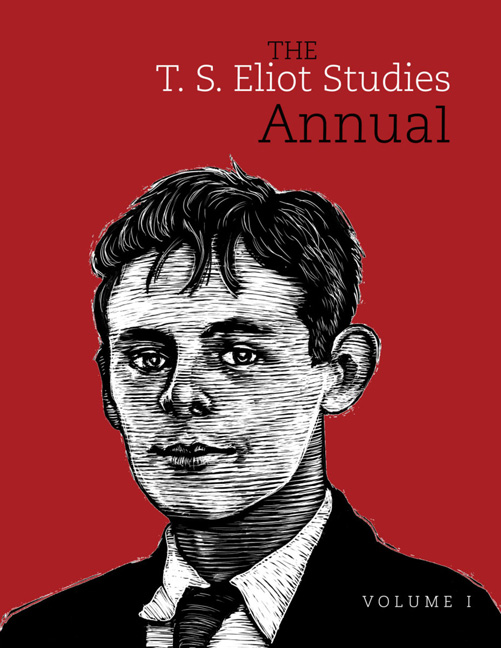Book contents
- Frontmatter
- Contents
- Abbreviations of Works
- General Editor's Note
- The Short and Surprisingly Private Life of King Bolo: Eliot's Bawdy Poems and Their Audiences
- Dull Tom-Tom's Absurd Prelude: Ludic Modernism in Early T. S. Eliot
- Eliot at Bergson's Lectures, 1910–1911
- The American Legacy of “Prufrock”
- Poetry (June 1915)
- The Stale Dregs of Revolt
- Prufrock, Belated
- Eliot's Allusive Legacy and Obscurity in “Prufrock”
- Transmuting F. H. Bradley: T. S. Eliot's Notes Towards a Theory of Poetry
- T. S. Eliot, Phenomenologist
- Astride the Dark Horse: T. S. Eliot and the Lloyds Bank Intelligence Department
- Aristophanic Structures in Sweeney Agonistes, “The Hollow Men,” and Murder in the Cathedral
- Eliot and Virgil in Love and War
- T. S. Eliot Bibliography 2014
- Notes on Contributors
Dull Tom-Tom's Absurd Prelude: Ludic Modernism in Early T. S. Eliot
- Frontmatter
- Contents
- Abbreviations of Works
- General Editor's Note
- The Short and Surprisingly Private Life of King Bolo: Eliot's Bawdy Poems and Their Audiences
- Dull Tom-Tom's Absurd Prelude: Ludic Modernism in Early T. S. Eliot
- Eliot at Bergson's Lectures, 1910–1911
- The American Legacy of “Prufrock”
- Poetry (June 1915)
- The Stale Dregs of Revolt
- Prufrock, Belated
- Eliot's Allusive Legacy and Obscurity in “Prufrock”
- Transmuting F. H. Bradley: T. S. Eliot's Notes Towards a Theory of Poetry
- T. S. Eliot, Phenomenologist
- Astride the Dark Horse: T. S. Eliot and the Lloyds Bank Intelligence Department
- Aristophanic Structures in Sweeney Agonistes, “The Hollow Men,” and Murder in the Cathedral
- Eliot and Virgil in Love and War
- T. S. Eliot Bibliography 2014
- Notes on Contributors
Summary
In a 1949 appreciation of T. S. Eliot, Clive Bell recalls receiving a postcard from his sister-in-law Virginia Woolf, sometime in the 1920s. “Come to lunch on Sunday,” it read, “Tom is coming, and, what is more, is coming in a four-piece suit.” Woolf's portrait of a farcically fastidious Eliot—which might sketch equally well a character in fiction—has become a stock image to biographers and critics alike, an easy tool to swell a progress or start a scene. These few deft strokes alternately pass for a portrait of the poet and stand as a metonym for a fading view of modernist levity. Yet as with all stock images, the cliché sharpens lines that are actually rather blurred, effacing a paradox behind the primness. In the same volume where Bell records Woolf's quip, Eliot's Harvard friend Conrad Aiken publicizes and palliates the then-obscure King Bolo as “a sort of cynical counterpoint to the study of Sanskrit and the treatise on epistemology.” Today, it is clear that more than a little crass schoolboy fun seeped through Eliot's studious demeanor, and that his mien and its lapses alike were theatrical. As Aiken writes elsewhere, “There was some of the actor in Tom and some of the clown, too. For all his liturgical appearance (he only lacked a turned-around collar, it sometimes seemed) he was capable of real buffoonery.” A clown in a four-piece suit: that seemingly paradoxical figure is the subject of this article. Next to our consensual sense of a dour, buttoned-up young Eliot writing searchingly urbane, serious poetry, we have the poetry itself— which saw him at play, toying with marionettes.
The longstanding vocabulary for understanding Eliot's marionette- play proceeds from his own prompting. Generations of critics have cited the influence of Jules Laforgue, whose ironic masks Eliot discovered in December 1908. Arthur Symons's The Symbolist Movement in Literature quoted the “travesty” of Laforgue's colloquialisms, neologisms, and unexpected allusions, with which “one can play, very seriously.” Laforgue played seriously by embracing Pierrot, the clown of the commedia dell'arte. In their history of the commedia, Martin Green and John Swan find Pierrot-figures most often evoked by artists who “rebelled against social norms and norm-subordinated art.”
- Type
- Chapter
- Information
- The T. S. Eliot Studies Annual , pp. 31 - 56Publisher: Liverpool University PressPrint publication year: 2017



